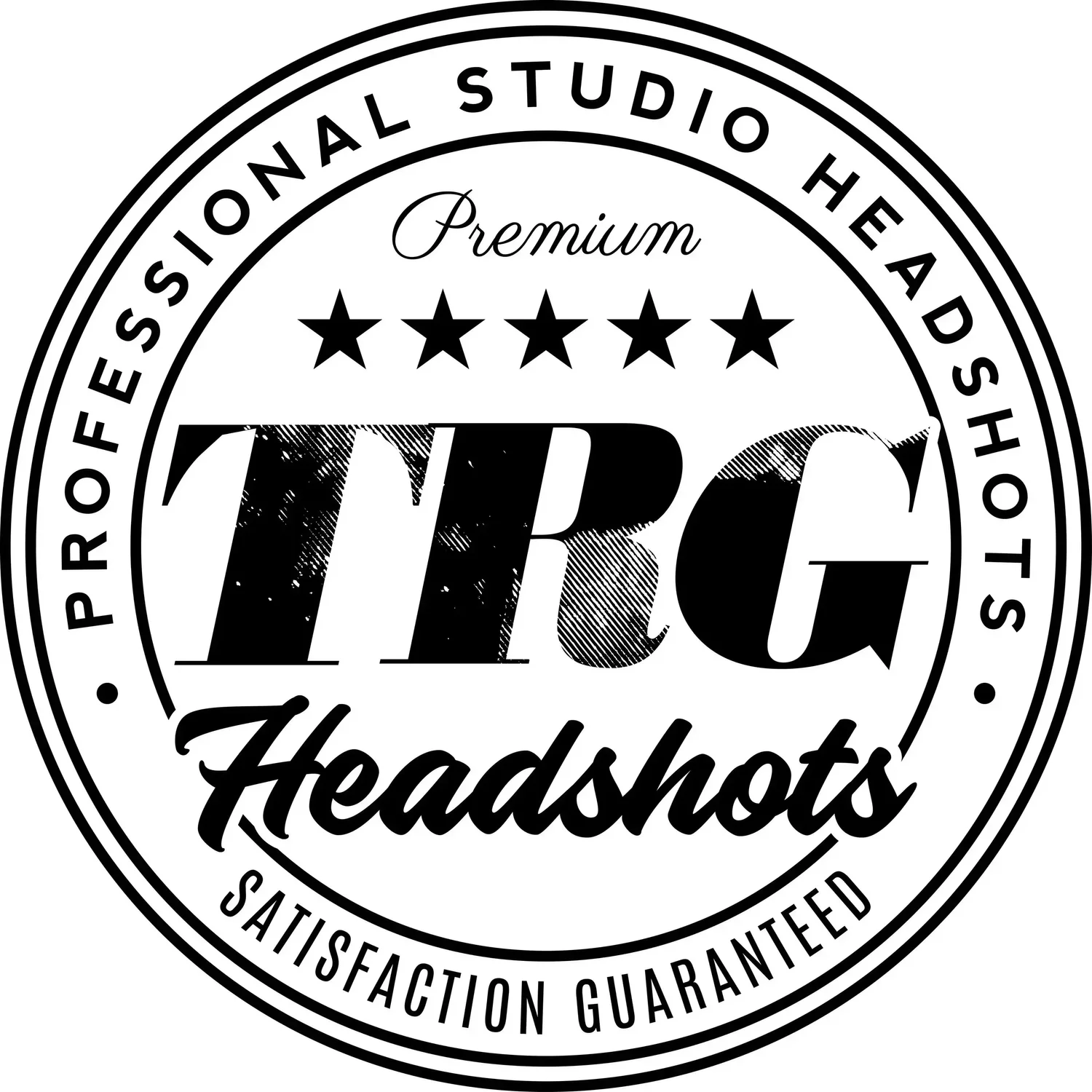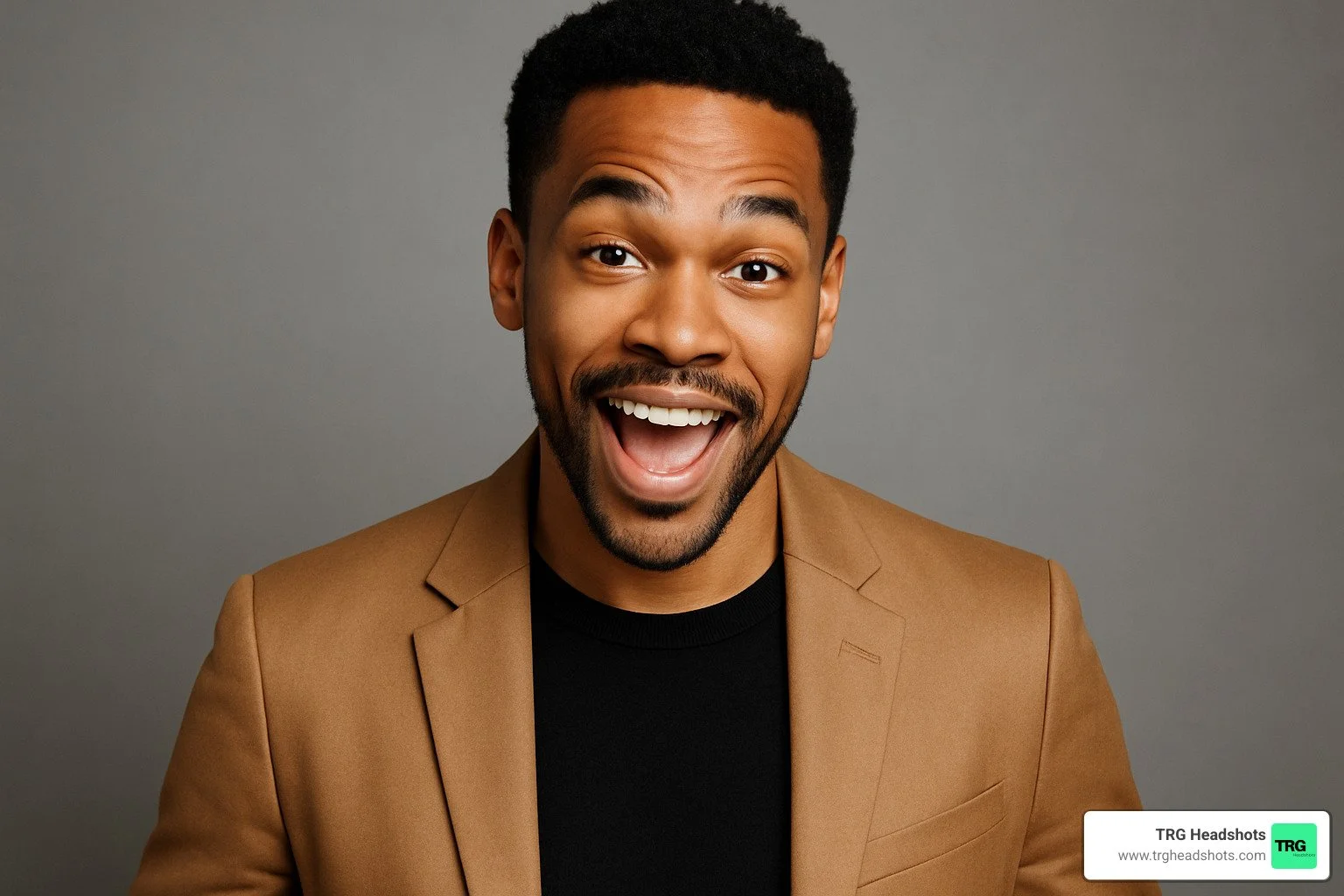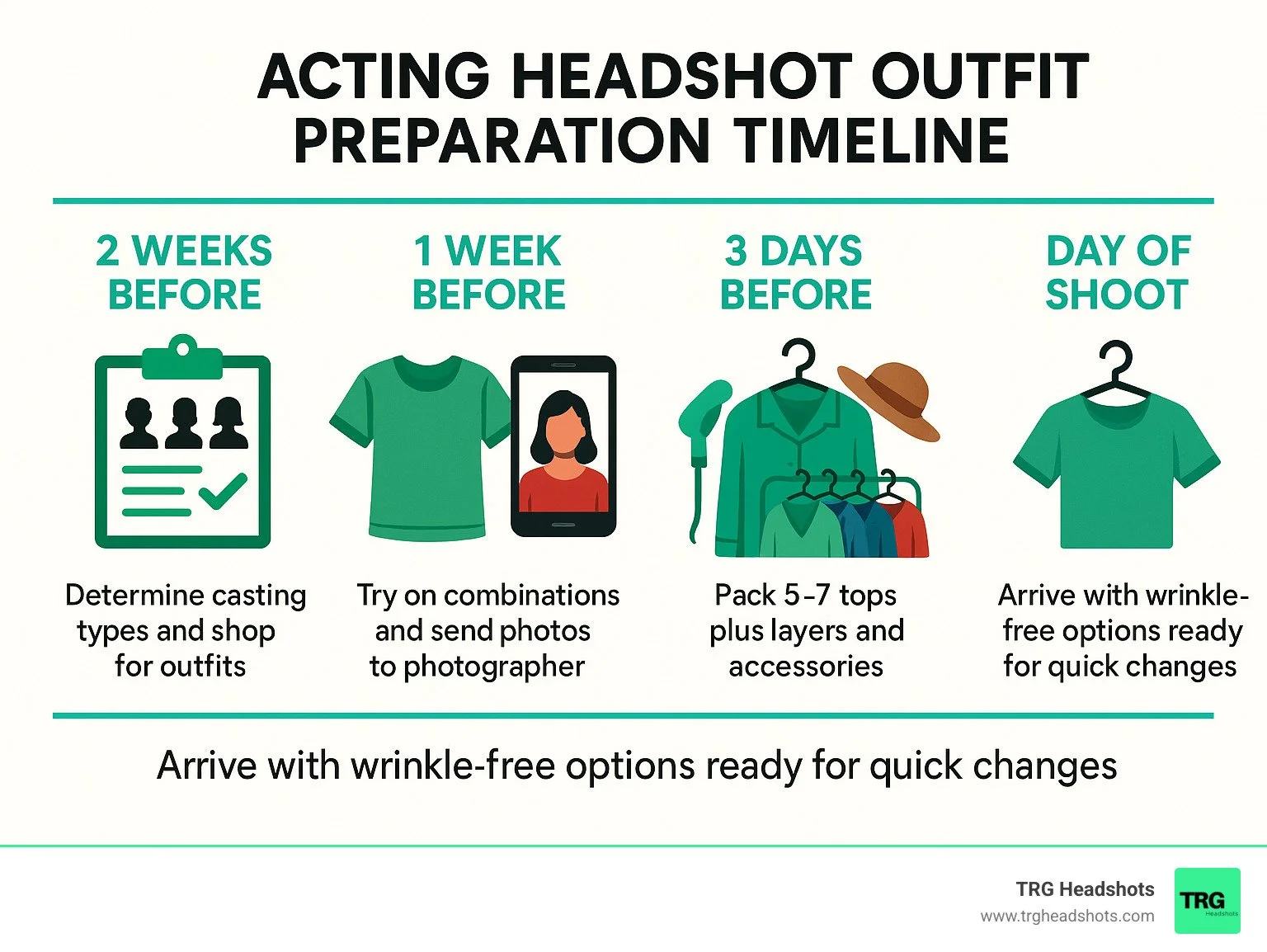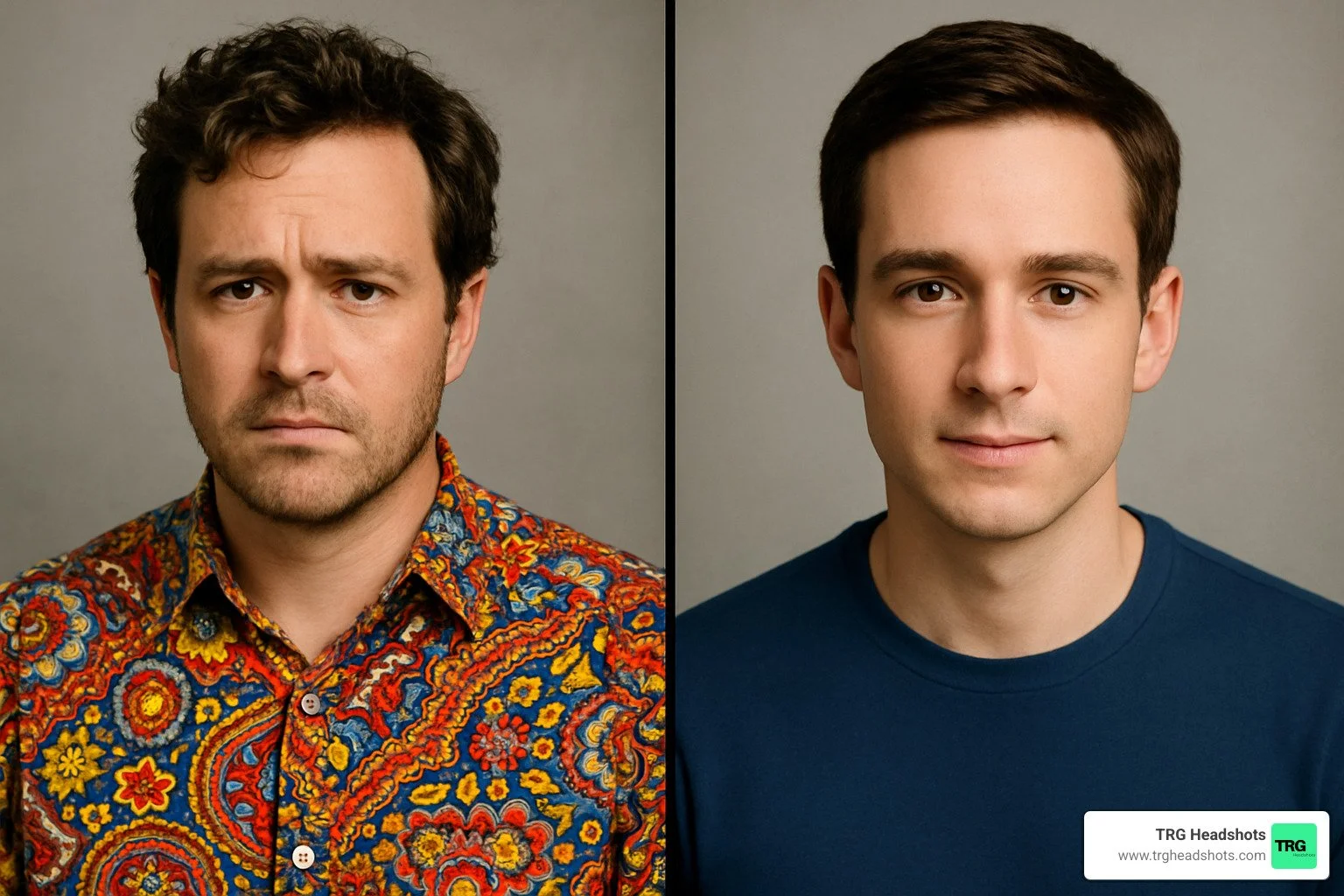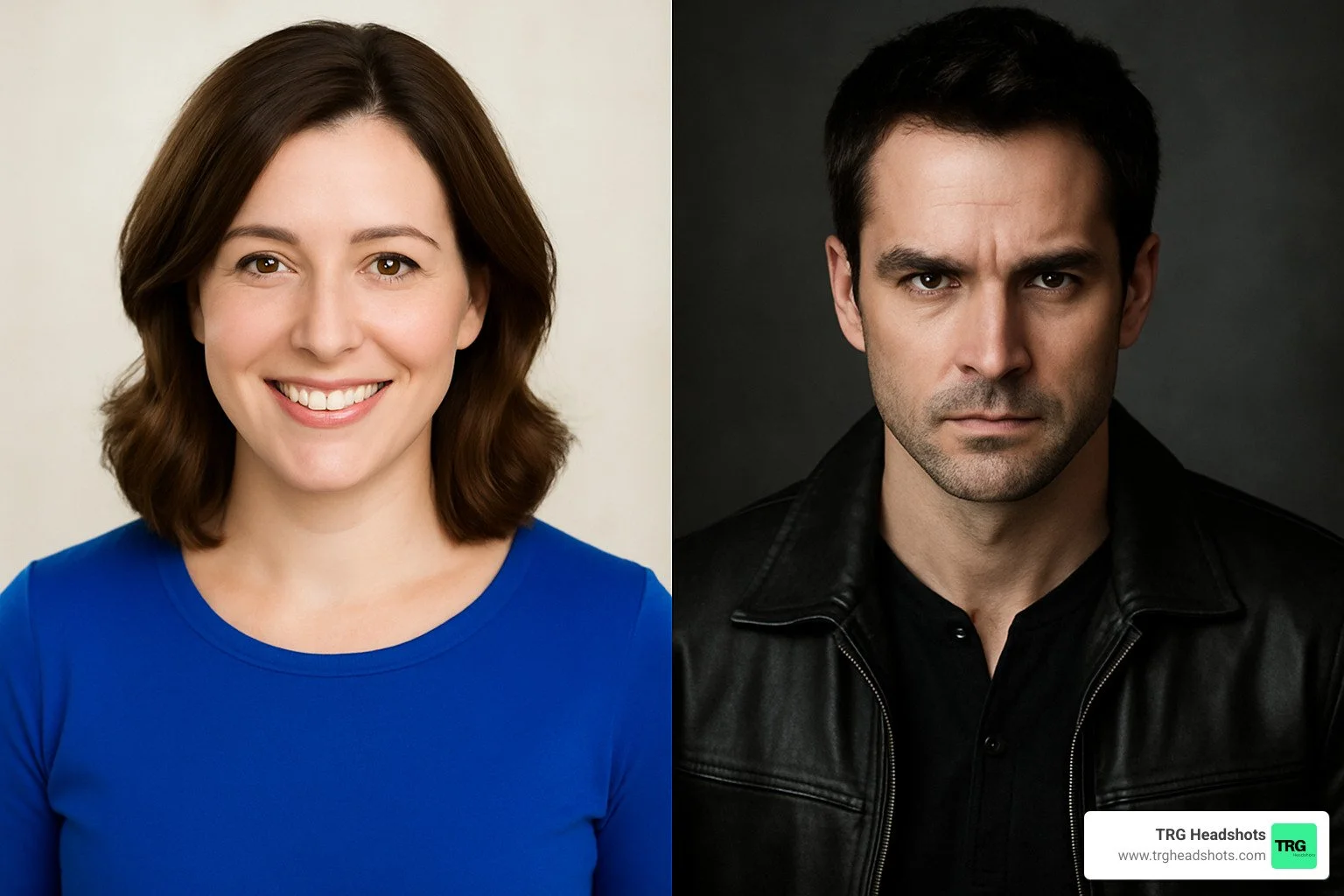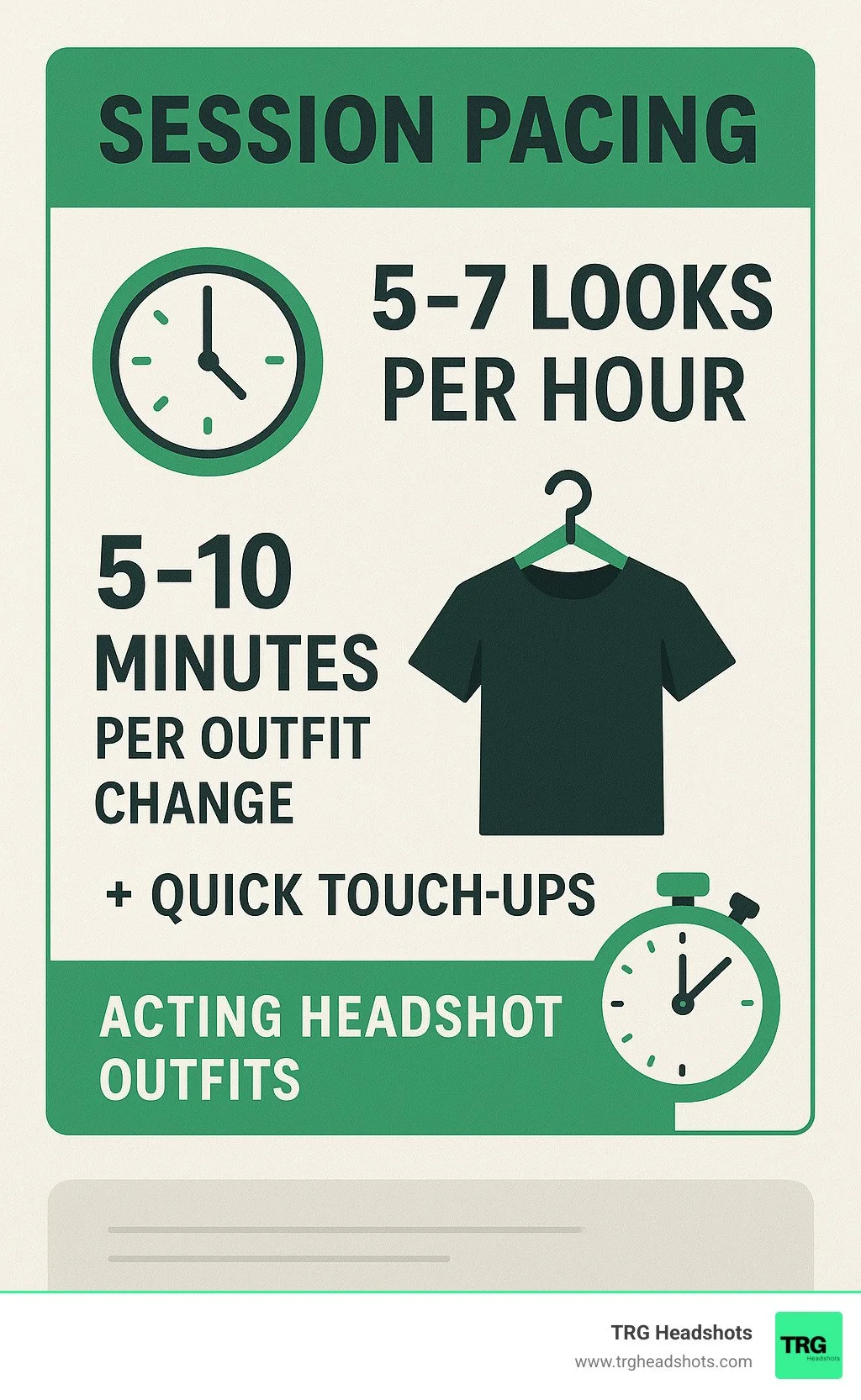Lights, Camera, Fashion! Choosing the Perfect Acting Headshot Outfits
Why Acting Headshot Outfits Can Make or Break Your Career
Acting headshot outfits are the secret weapon that transforms good photos into booking gold. Your wardrobe choices can literally determine whether casting directors stop scrolling or keep moving past your headshot in their search results.
Quick Answer for Acting Headshot Outfits: • Solid colors in jewel tones (navy, burgundy, forest green)
• Fitted clothing that flatters without being tight
• Matte fabrics like cotton - avoid shiny materials
• Minimal accessories - keep focus on your face
• 5-7 outfit changes for a typical one-hour session
• No logos, patterns, or white - they distract from you
As one headshot photographer noted, "What you wear in your headshot is so important that, unlike most photographers, I don't limit the number of looks in any of my headshot packages." That's because your outfit tells casting directors who you are before you even speak.
The reality is stark: Poor wardrobe choices can kill your chances of getting booked for a role. But the right outfit? It becomes your silent partner, helping you embody the character and giving casting directors exactly what they need to see.
Your headshot isn't just a pretty picture - it's a marketing tool. Every color, fabric choice, and styling decision either supports your casting type or works against it. The actors who understand this land more auditions.
I'm Travis Massengill, and after pivoting to headshot photography during Covid, I've helped hundreds of Dallas actors nail their wardrobe choices for maximum booking potential. Through my private studio work, I've seen how the right acting headshot outfits can transform an actor's confidence and career trajectory.
Why Wardrobe Matters on Camera
Think of your acting headshot outfits as your silent audition partner. Before you even speak a line, your clothing is already telling casting directors who you are, what roles you fit, and whether you understand the business.
The camera sees everything differently than your eye does. What looks perfectly fine in your mirror can turn into a distracting mess on screen. Those cute tiny stripes on your favorite shirt? They create something called a moiré effect - wavy, squiggly patterns that make camera sensors go haywire. It's like visual static that pulls attention away from your face.
Here's the truth that might surprise you: actors with thoughtfully chosen wardrobe report booking 1-2 auditions per week instead of 1-2 per month. Your outfit acts as a visual shortcut, helping busy casting directors instantly see you in the right roles.
The thumbnail test is everything in today's digital casting world. When your headshot appears as a tiny image on a casting director's screen, your outfit needs to read clearly even at that small size. Busy patterns, shiny fabrics, and distracting logos all fail this crucial test.
I've watched actors sabotage themselves with wardrobe choices they thought looked "interesting." A silk blouse creates hot spots under studio lighting. A shirt with a large logo becomes the star of the photo instead of the actor. These aren't creative choices - they're booking killers.
Your wardrobe should support brand consistency across all your marketing materials. If you're targeting "young professional" roles, every outfit choice should reinforce that image. Think of successful actors - their headshots, reels, and even social media photos all tell the same visual story.
The Psychology Behind Clothing Choices
Colors hit our brains faster than conscious thought. When a casting director sees navy blue, they subconsciously think "trustworthy" and "reliable" - perfect for the dependable best friend or honest lawyer character. Burgundy whispers sophistication without screaming for attention.
This isn't just fashion theory - it's casting strategy. The right colors make it effortless for casting directors to picture you in specific roles. Red conveys passion and intensity, ideal for dramatic characters but potentially overwhelming for a cheerful commercial about breakfast cereal.
Authority cues work just as powerfully. A well-fitted blazer instantly lifts your perceived status, opening doors to executive and professional roles. An open cardigan over a simple top suggests approachability - exactly what commercial casting directors want to see.
The magic happens when your clothing choices align with the emotional tone of your target roles. You're not just wearing clothes; you're wearing possibilities.
Determining Your Casting Type Before Shopping
Before you spend a dime on new clothes, you need to know exactly who you're marketing. Smart actors identify 3-4 specific character archetypes they want to target. This isn't about limiting yourself - it's about giving casting directors exactly what they're searching for.
Your casting type combines your age range, personality traits, and the kinds of characters you naturally embody. A 30-year-old man might market himself as "Young Dad," "Tech Professional," "Workout Enthusiast," and "Reliable Best Friend." Each type demands different wardrobe choices.
Here's a research trick that works every time: Google Image Search your target types. Search phrases like "young professional headshot" or "soccer mom actor" and study what successful actors in those categories are wearing. This visual research will guide your shopping better than any generic style advice.
Your acting headshot outfits should make casting directors think, "Perfect! That's exactly what I need for this role." When your wardrobe speaks their language, the bookings follow.
Acting Headshot Outfits: Color, Fit & Fabric
Getting your acting headshot outfits right comes down to mastering three simple elements: picking the right colors, nailing the fit, and choosing camera-friendly fabrics. Master these basics, and you're already ahead of most actors walking into casting rooms.
Solid colors are your secret weapon. They keep all eyes on your face while giving you the contrast needed to stand out against any backdrop. Jewel tones like sapphire blue, emerald green, and deep purple photograph like magic and flatter almost everyone. Earth tones such as burgundy, navy, and forest green bring sophistication without screaming for attention.
Here's the thing about fit—it's make-or-break territory. Your clothes should follow your body's natural shape without clinging or drowning you in fabric. Even if baggy is your everyday style, fitted clothing works better on camera because it creates clean, flattering lines that don't compete with your face.
Matte fabrics are your best friend under studio lights. Cotton, wool, and quality fabric blends hold their color beautifully and photograph without unwanted shine or reflections. Long sleeves generally beat sleeveless tops—they're less distracting and create a more polished look that keeps focus where it belongs.
Skip the neon colors entirely. They create a glow effect under professional lighting that makes you look like you're radioactive. The magic happens in layers—bringing a cardigan, blazer, or denim jacket gives you multiple looks from one base outfit.
Best Colors for Acting Headshot Outfits
Color choice can turn a good headshot into a booking machine. The trick is finding colors that create beautiful contrast with your skin while supporting the characters you want to play.
If you have lighter skin, white, yellow, light pink, and pastels will make you disappear into the background. Instead, reach for darker, richer colors that define your features and make you pop. For darker skin tones, brown, black, and navy might blend too much with your complexion. Brighter, lighter colors will make you absolutely glow.
Here's a game-changing tip: match one outfit to your eye color. Blue eyes become absolutely stunning in a blue shirt. Green eyes turn mesmerizing in forest green. This simple trick transforms ordinary headshots into the kind casting directors bookmark.
Color psychology works in your favor too. Warm colors like reds and oranges make you look friendly and energetic—perfect for commercial auditions. Cool colors like blues and purples suggest calm professionalism—ideal when you're going after dramatic roles or corporate characters.
The best complementary color combinations create natural contrast without being jarring. Think navy with your skin tone, burgundy against most complexions, or deep purple for something a little different but still professional.
Fabrics & Patterns: Acting Headshot Outfits That Play Nice with Sensors
Not every fabric loves the camera, and some can actually sabotage your shoot before it starts. Digital camera sensors get confused by certain textures and patterns, creating problems that even the best photographer can't fix.
Cotton is the gold standard for headshots. It's naturally matte, holds color beautifully, and drapes in a flattering way. Denim works wonderfully for casual, approachable looks. Quality wool adds subtle texture without being distracting. A leather jacket instantly adds edge for dramatic character types.
Here's what will cause you headaches: ribbed textures create that weird squiggly moiré effect that makes your shirt look like it's vibrating. Scientific research on moiré patterns shows these small, repetitive patterns confuse digital sensors and create visual problems that are nearly impossible to fix later.
Small prints are a no-go for the same reason. That cute tiny floral pattern or micro-check might look great in person, but it turns into a distracting mess on camera.
Silk and velvet might feel luxurious, but they're trouble under studio lights. Silk creates hot spots and reflections that pull focus from your face. Velvet can look either completely flat or overly textured depending on how the light hits it.
Wrinkle-free tricks save the day: Steam or iron everything the night before your session. Pack clothes on hangers when possible, and bring wrinkle-release spray as backup. Even small creases become dramatic under professional lighting, so this step isn't optional.
Styling for Casting Types: Commercial vs. Theatrical
The difference between commercial and theatrical acting headshot outfits is like the difference between a friendly coffee date and a dramatic movie scene. Each style tells casting directors exactly what kind of roles you're perfect for.
Commercial headshots are all about being the person everyone wants to be friends with. These shots book you commercials, sitcoms, and those "real people" roles where you're selling products or playing the relatable neighbor. Your wardrobe should whisper "approachable" and "trustworthy."
For commercial looks, bright palettes work beautifully. That royal blue shirt makes your eyes sparkle. An emerald green sweater suggests someone who's put-together but not intimidating. Rich purple tops photograph like magic under studio lights. These jewel tones create the perfect balance—polished enough for TV but warm enough to sell breakfast cereal.
Layering adds visual interest without stealing focus from your face. An open cardigan over a fitted tee says "mom next door." A denim jacket over a solid shirt suggests "fun dad" or "cool older sister." These combinations give casting directors multiple character reads from a single outfit.
Theatrical headshots dive deeper into character and emotion. Here's where you can accept subdued earth palettes and dramatic styling choices. Think sophisticated, complex, ready for the emotional heavy lifting that film and television drama demands.
For theatrical looks, that burgundy henley suggests leading man potential with depth. A charcoal blazer over a dark tee conveys professional authority with an edge. Leather jackets add instant intensity—perfect for characters with complicated backstories.
The key difference? Commercial says "hire me because I'm likeable." Theatrical says "hire me because I can carry your story." Both are valuable, and the Backstage guide to commercial vs theatrical emphasizes matching your outfit energy to the roles you're seeking.
Using Accessories & Layers to Signal Character
Here's where small choices make big impacts. The right accessories transform basic acting headshot outfits into specific character types that casting directors can instantly categorize.
Jackets are your secret weapons for character change. That same fitted tee becomes three different people depending on what you layer over it. Add a denim jacket? You're the approachable rebel with a heart of gold. Throw on a leather jacket? Now you're the edgy bad boy with mysterious depth. Layer a navy blazer? Suddenly you're the young professional climbing the corporate ladder.
Glasses without lenses create instant "smart person" energy. Buy cheap frames from any pharmacy, pop out the lenses to avoid reflections, and you've got a $20 character accessory. Perfect for teacher, lawyer, or "tech genius" types.
Minimal jewelry works best. Small stud earrings add polish without distraction. A simple necklace can provide personality without becoming the star of the photo. But leave those chandelier earrings at home—they'll compete with your face for attention.
Scarves add sophistication and color, especially for women. A lightweight scarf can soften a blazer for "executive with heart" energy or add elegance to a simple top. Just ensure it improves rather than overwhelms your look.
Remember the golden rule: accessories should support your story, not tell their own.
Age & Gender Considerations
Different life stages call for different wardrobe strategies in your acting headshot outfits. What works for a teenager won't work for a senior, and that's exactly the point.
Kids and tweens shine in vibrant colors. Solid jewel tones like turquoise, royal blue, or bright red capture youthful energy beautifully. Let children look their age—denim overalls, bright sweaters, and fun colors create that authentic kid energy casting directors love for young roles.
Teenagers can accept current trends while staying camera-friendly. Graphic tees under hoodies work for "gamer" types. Fitted henleys suggest "athlete" or "leading teen" potential. Just avoid trends that will date your photos quickly—you want these headshots to work for at least two years.
Adults benefit from strategic neckline choices. V-necks are universally flattering and photograph beautifully, especially for men. Lower necklines generally work better than high ones, but modesty matters. Skip the turtlenecks—they can make your head look like it's floating above your body.
Seniors look fantastic in textured fabrics that add visual interest and convey wisdom. A cable-knit sweater, tweed blazer, or textured cardigan suggests experience and depth while staying camera-friendly.
The goal isn't to hide your age—it's to look like the best, most castable version of yourself at whatever stage you're in.
Preparation Checklist & Session Logistics
Success in headshot sessions comes down to preparation. Here's your complete checklist for acting headshot outfits that will maximize your session results.
Two weeks before: Determine your casting types and start shopping. Try on everything at home and take phone photos to see how combinations look on camera.
One week before: Finalize your outfit choices and send photos to your photographer for feedback. This collaboration ensures your wardrobe works with their lighting and background choices.
Three days before: Steam or dry-clean everything. Check for loose buttons, pulled threads, or stains. Make any necessary repairs.
Day before: Pack 5-7 tops plus layers and accessories. Use hangers or lay flat to prevent wrinkles. Include backup options—it's better to have too many choices than too few.
Must-pack items:
5-7 fitted tops in different colors
2-3 jackets or cardigans for layering
Multiple bottom options (dark jeans, dress pants)
Minimal jewelry options
Glasses (lens-free if you don't normally wear them)
Wrinkle-release spray
Lint roller
Small sewing kit for emergencies
For a typical one-hour session, plan for 5-7 completely different looks. Two-hour sessions can accommodate 8-12 looks with more elaborate styling changes. Quick outfit changes keep energy high and maximize your photo options.
Collaborating With Your Photographer & Agent
The best headshot sessions are collaborative efforts. At TRG Headshots, we offer pre-shoot consultations specifically to discuss wardrobe choices and ensure your outfits work perfectly with our lighting and backgrounds.
Text outfit photos to your photographer beforehand. This simple step can save valuable session time and ensure every outfit works beautifully on camera. We often suggest minor adjustments—a different neckline, a complementary color, or an additional layer—that can lift your entire look.
Your agent's input is invaluable too. They know what casting directors are requesting and can guide your wardrobe choices toward bookable looks. If they're asking for "young mom" types, your outfit strategy will be different than if they need "corporate professional" shots.
During the session, trust your photographer's eye. We see how outfits translate through the lens and can make real-time adjustments. Sometimes unbuttoning a jacket, rolling up sleeves, or adding a simple accessory can transform a good shot into a great one.
Background coordination matters too. Our live preview system lets you see exactly how your outfit works with different backdrop options, ensuring every combination is perfect before we capture it.
Hair & Makeup That Complement Acting Headshot Outfits
Your hair and makeup should improve your acting headshot outfits, not compete with them. The goal is natural, polished, and camera-ready.
Schedule haircuts 1-2 weeks before your session, allowing time for the style to settle. Avoid dramatic changes right before shooting—stick with refined versions of your current look.
Makeup should be matte and natural. Studio lights can wash out your features, so slightly more makeup than usual is often necessary. Avoid shimmer and glitter—they create unwanted reflections. Men should consider light powder to control shine, especially if you have oily skin.
Beard grooming matters for men. Whether you're clean-shaven or bearded, ensure everything is trimmed and neat. Bring grooming tools for touch-ups between looks.
Hair styling should complement your outfit choices. If you're going for "corporate professional," sleek styling works better than messy, casual looks. For "creative type" shots, more relaxed styling might be perfect.
The key is consistency—your hair and makeup should support the story your outfit is telling, not distract from it.
Frequently Asked Questions about Acting Headshot Outfits
These are the questions I hear most often from actors preparing for their headshot sessions. After photographing hundreds of Dallas actors, I've learned that getting these details right can make the difference between a good session and a great one.
How many looks should I plan for one session?
The sweet spot for acting headshot outfits in a one-hour session is 5-7 completely different looks. This gives you enough variety to show your range without rushing through changes or sacrificing quality for quantity.
Each look should tell a different story about who you could play. Think "young professional," "girl next door," "edgy creative," or "approachable mom." Every outfit change is an opportunity to market yourself for different types of roles.
Here's what I always tell my clients: bring more options than you think you'll need. Pack 10 tops even if you only plan to use 6. There's nothing worse than running out of good choices halfway through your session. Plus, having backup options gives us flexibility to adjust based on what's working best with the lighting and backgrounds.
For longer sessions, we can certainly capture more looks, but remember—casting directors would rather see 5 amazing shots than 10 mediocre ones. Quality always wins over quantity.
Should I ever wear white, black, or bold patterns?
This is probably the most common wardrobe question I get, and the answer is more nuanced than a simple yes or no.
White can work, but it requires the right approach. I've seen white look stunning when layered under a darker jacket or cardigan. It can also work for very specific character types—think "innocent ingenue" or "medical professional." But wearing white alone often washes out your features and pulls attention from your face.
Black is actually more versatile than many people realize. If you have lighter hair or fair skin that creates good contrast, black can look sophisticated and dramatic. However, textured dark gray or charcoal often photographs more interestingly than flat black.
Bold patterns are almost always a mistake for headshots. They create visual competition with your face—and your face should always be the star. Patterns can also cause technical problems with camera sensors, creating those squiggly moiré effects that are nearly impossible to fix.
If you absolutely love a subtle pattern, make sure it's small and pair it with a plain background. But honestly? Solid colors will serve you better 99% of the time.
Can I keep my glasses or jewelry on in my headshots?
Glasses are totally fine in headshots—in fact, many agents now specifically request shots both with and without glasses for maximum versatility. The key is making sure they don't create reflections or hide your beautiful eyes.
I often suggest having the lenses removed for the shoot if you're comfortable with that. It eliminates any reflection issues while keeping the frames as part of your look. If you prefer to keep the lenses in, we'll work together to angle them properly so they don't interfere with the lighting.
For jewelry, less is definitely more. Small stud earrings, a simple necklace, or a classic watch can add personality without becoming distracting. I've seen too many great shots where a chunky bracelet or dangly earrings became the focal point instead of the actor's face.
Avoid anything shiny, trendy, or oversized. Your acting headshot outfits and accessories should support your face, not compete with it. When in doubt, take it off—you can always add it back if we decide it improves the shot.
The goal is creating images that casting directors remember for all the right reasons. Your talent should be the star, with everything else playing a supporting role.
Conclusion
The perfect acting headshot outfits aren't about following a complicated style rulebook—they're about making smart choices that help casting directors see you in the roles you want to book. When you understand how clothing communicates character, your wardrobe becomes one of your most powerful career tools.
Think of it this way: every time a casting director scrolls through headshots, they're making split-second decisions about who fits their vision. Your outfit is working for you (or against you) in that crucial moment. The actors who get this land more auditions, plain and simple.
Your wardrobe success formula is actually pretty straightforward. Solid colors that make your skin glow, fitted clothing that follows your natural lines, matte fabrics that love studio lights, and minimal accessories that add character without stealing focus. Layer smart to create multiple looks efficiently, and always pack more options than you think you'll use.
The versatility factor can't be overstated. When you nail your acting headshot outfits, you're not just getting one great photo—you're creating a collection of images that can market you for different roles. That burgundy henley might book you the leading man audition, while the navy blazer gets you in the room for the lawyer role.
Here's what we've learned after hundreds of sessions: confidence shows up in photos. When actors feel great in their clothes, it radiates through the camera. When they're worried about how they look or uncomfortable in their outfit, that shows up too. The right wardrobe choices don't just look good—they make you feel ready to book.
At TRG Headshots, we've built our entire process around helping Dallas actors succeed. From pre-shoot wardrobe consultations to live previews that let you see exactly how each outfit translates on camera, we're invested in your results. Our 100% satisfaction guarantee means you only pay if you love your images—because we believe great headshots should boost your confidence, not add to your stress.
More info about Actor Headshots Dallas shows how our collaborative approach turns wardrobe strategy into booking power. We don't just take your picture—we help you create marketing materials that work.
Your next breakthrough role might be waiting for the perfect headshot to open up it. Make sure your acting headshot outfits are ready to open that door.
